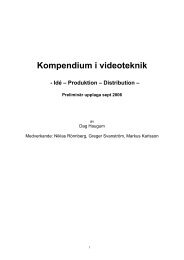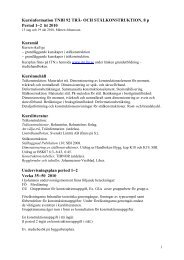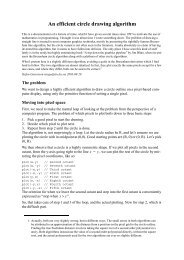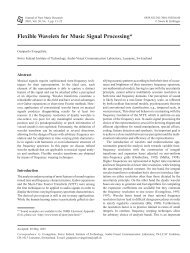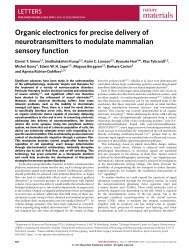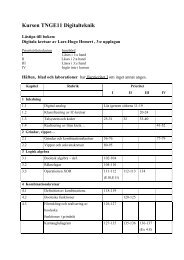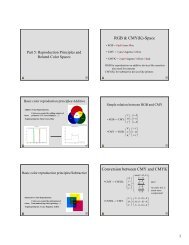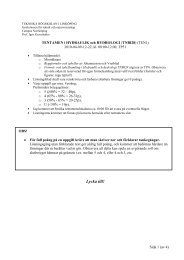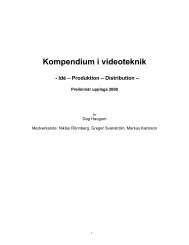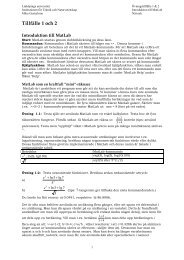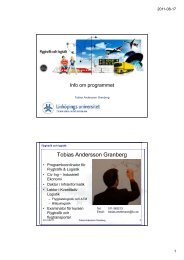Course Information - Linköping University
Course Information - Linköping University
Course Information - Linköping University
You also want an ePaper? Increase the reach of your titles
YUMPU automatically turns print PDFs into web optimized ePapers that Google loves.
<strong>Linköping</strong> <strong>University</strong> <strong>Course</strong> <strong>Information</strong> 2011<br />
Campus Norrköping 2012-01-05<br />
ITN<br />
David Gundlegård<br />
<strong>Course</strong> <strong>Information</strong><br />
TNK110 Mobile communication and Networks, 6 ECTS credits<br />
<strong>Course</strong> description<br />
The course aims to provide knowledge in mobile communications, especially different system<br />
characteristics and their effect on wireless network performance. The mobility puts high requirements<br />
on the communication system and these requirements together with possible solutions are an essential<br />
part of the course. The course focus on<br />
wireless network performance and trade-offs<br />
cellular network planning and modelling<br />
radio resource management (RRM) and mobility management (MM)<br />
wireless wide area network (WWAN) architectures.<br />
The course covers the whole semester, where the first period is mainly focused on theory and labs and<br />
is concluded with the written exam. The second period will be focused on the written assignment.<br />
Aim<br />
The students should after completing the course be able to:<br />
Identify the most important components and functions of a mobile communication system<br />
Explain the differences in characteristics between different types of mobile communication<br />
systems and motivate their existence<br />
Compare and explain areas of applications for different mobile communication systems<br />
Relate functions, terms and technologies to the correct level in a communication system<br />
architecture<br />
Argue for the role of the mobile communication systems in different applications<br />
Evaluate trade-offs between different mobile communication technologies and systems<br />
Quantitatively model and evaluate selected parts of a mobile communication system<br />
Apply previous knowledge from statistics, modeling, programming and<br />
data/telecommunications in the area of mobile communications<br />
Define and calculate key performance metrics of a mobile communication system<br />
Assess the performance of different mobile communication technologies given a set of<br />
application requirements<br />
Apply models and methods for planning of cellular networks<br />
Independently plan, perform and document a research oriented project in the area of mobile<br />
communications<br />
Connection to other courses<br />
Knowledge from TNK040 Telecommunication Systems, TNK108 Computer Networking or TNE066<br />
Telecommunication will be used to see how it is applied in a mobile communication system.<br />
Supplementary courses are TNK080 Wireless Communication Systems, TNK092 Network Simulation<br />
and TNK110 Positioning Systems.<br />
1
Time plan<br />
Lectures: scheduled time 22h, preparation time 11h.<br />
Tutorials: scheduled time 6h, preparation time 6h.<br />
Project assignment and lab: 53h<br />
Post lecture/tutorial work (= written exam preparation): 62h.<br />
<strong>Course</strong> literature<br />
As course literature Wireless Communications and Networking by Vijay Garg is used. The book can be<br />
purchased in Bokakademin, with new location on floor 5 in Täppan (close to the student coffee shop).<br />
The book is also available as e-book in the library.<br />
As reference literature the following titles are relevant:<br />
Mobile Radio Networks – Networking, Protocols and Performance by Walke (e-book available<br />
from <strong>Linköping</strong> <strong>University</strong> Library)<br />
Principles of Wireless Communication by Ahlin et. Al (course literature in TNK080)<br />
Radio Resource Management for Wireless Networks by Zander and Queset<br />
Mobile Communications by Schiller<br />
Selected parts of Data and Computer Communications by William Stallings and Computer<br />
Networking – A Top Down Approach by Kurose and Ross are useful<br />
Supplementary material will be handed out on lectures or available on the course web page.<br />
<strong>Course</strong> webpage<br />
www.itn.liu.se/~davgu/tnk110<br />
Examination<br />
The course consists of one written exam (2012-03-07 at 14-18 a.m.), a project and two lab exercises.<br />
Project: develop and evaluate algorithm for RRM or MM<br />
Lab exercises: TEMS Investigation<br />
More information about the project and the labs are available on the course web page.<br />
Teaching staff<br />
Lecturer and examiner<br />
David Gundlegård<br />
Spetsen 7:th floor<br />
Tel. 011-363316<br />
Email: davgu@itn.liu.se<br />
Web: www.itn.liu.se/~davgu<br />
Project and labs<br />
Sara Modarres Razavi<br />
Email: sara.modarressi.razavi@liu.se<br />
2
Lecture plan (tentative)<br />
The lectures will cover the fundamentals of mobile communication theory. We will follow the OSI<br />
model, beginning with the lowest layer and work our way upwards to the network layer. Lecture 9-10<br />
covers specific systems and some planning and design issues in WWAN. The lecture plan is tentative<br />
and changes may be made during the course. The chapter references for each lecture refer to the course<br />
literature. However, these are tentative and detailed reading advices will be given for each lecture.<br />
Lecture 1 Introduction Ch 1<br />
<strong>Course</strong> information, connection to other courses, introduction to wireless<br />
networks, PAN/LAN/MAN/WAN<br />
Lecture 2 Wireless data and telecommunication Ch 2, 4<br />
The OSI model, modelling and analysis, teletraffic engineering<br />
Lecture 3 Radio interface Ch 3.1, 3.2,<br />
Modulation, frequency spectrum, introduction to wireless 3.5, 4<br />
propagation and fading, bitrate vs baudrate, key wireless network parameters<br />
Lecture 4 Multiple access Ch 6<br />
Hidden and exposed terminal, reservation based access, random access<br />
Lecture 5 Cellular systems Ch 5<br />
Cellular network modelling, performance metrics, trade-offs<br />
Lecture 6 WWAN Architecture Ch 7<br />
General architecture, logical channels, signalling<br />
Lecture 7 Mobility Management (MM) Ch 12.1-4,<br />
Location update and paging strategies, mobility management modelling, signalling Handout<br />
Lecture 8 Radio Resource Management (RRM) 12.5<br />
Handover techniques and types, handover parameters and decisions, mobility modelling Handout<br />
Lecture 9 GSM Ch 15<br />
Architecture, characteristics, channel and protocol design, data traffic support, performance<br />
Lecture 10 UMTS , WWAN planning and WLAN Ch 15, 17,<br />
Architecture, characteristics, channel and protocol design, data traffic support, 21<br />
performance<br />
Lecture 11 Summary<br />
<strong>Course</strong> overview and selected topics for repetition<br />
3



